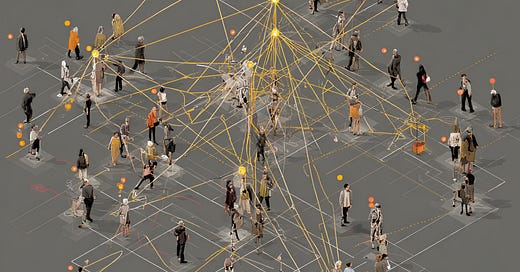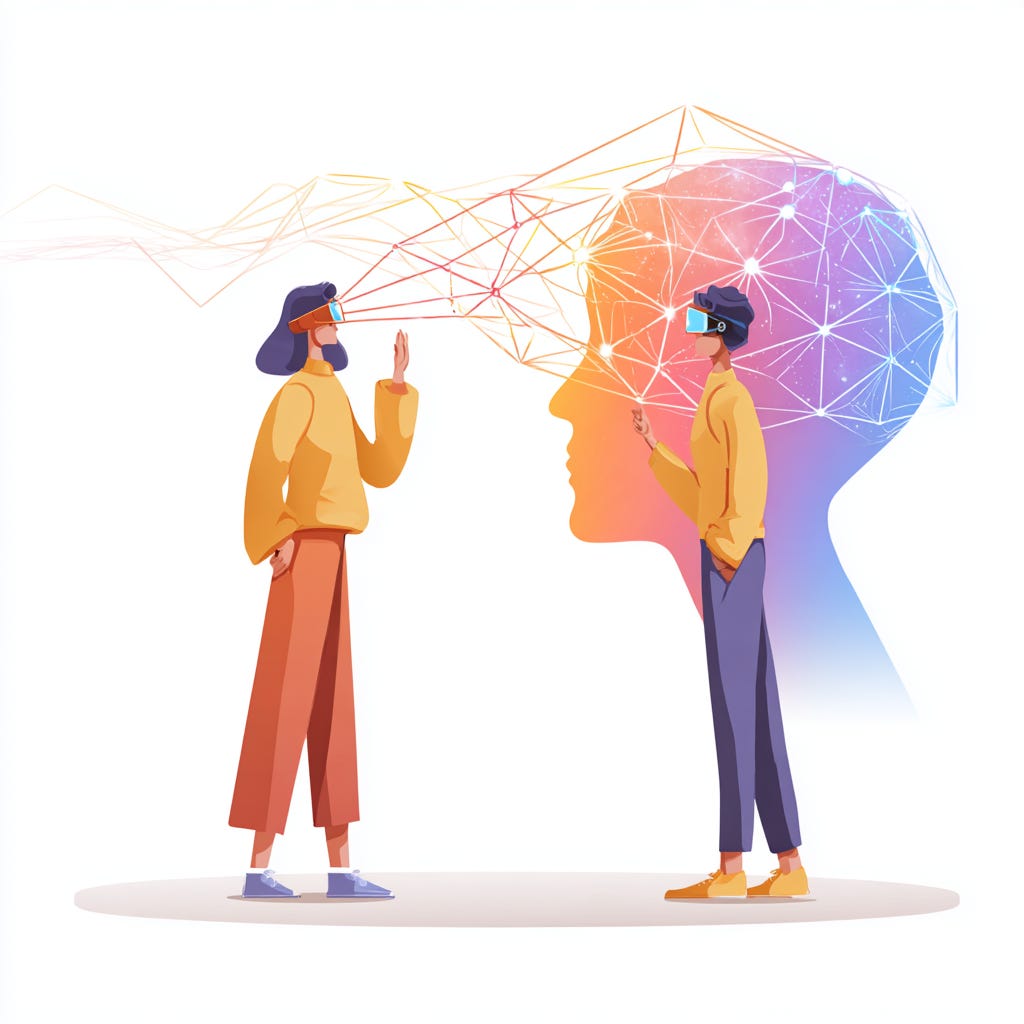Greetings from late June in northern Virginia, where heat and dew point make for a very muggy time. It’s the kind of weather which makes you cling to air conditioning when the sun is blazing in a metallic sky, only venturing out early morning or late at night. The cats venture outside for some brief sun, then gracefully retreat inside to recover and demand food.
Today I wanted to share an AI idea I’ve been noodling on. It’s not quite finished, but I wanted to get it out there for feedback and perspective. The idea is that we are seeing the rise of a stratum of multiple AI applications interacting between people and organizations. For lack of a more felicitous phrase I’m calling it the AI intermediary layer.
Caveats: I’m not talking about layers within the technology, such as multiple levels in deep learning. Instead, I’m referring to the human use of AI. I’m also not describing a particular stack of individual components, as it’s too early to tell if a precise ecosystem has emerged. I’m also not claiming AI is the first intermediary layer between people. Obviously other systems and entities play and have played that interpersonal interface role: culture, language, other technologies, etc.
Instead what I’m seeing is what happens when a person uses AI to reach out into the world, and at the other end of the exchange is another person deploying AI. They aren’t using the same application, most likely, but each is setting their own into motion and the two interact. Think of a commercial example. I would like to see a movie in a theater, so I fire up an agent which will check the web for what’s playing and where, informed by my preferences (horror yes, no rom-coms), linked to my calendar connected to a credit card. The agent will sift through data and options, then present me some options.
On the other end of the exchange, a given movie theater’s manager runs an AI agent to market their movies and sell tickets to them. That application starts with the theater’s data (movie titles, times, prices, locations) and connects to their website and mobile app, along with other media (local news sites, etc). Depending on its settings the movie theater AI might provide marketing and sales analysis, then adjust offerings accordingly.
So the would-be ticket buyer and would-be ticket vendor interact through this matrix of at least two AIs, plus the various data systems and other applications involved. The AIs enable, shape, and can ultimately complete these transactions.
We could consider a not-so-commercial example. Alice is researching early 20th-century Russian literature. She sends an AI to look through the Web for articles about various issues in Bulgakov. As the AI brings back findings, Alice adjusts it in response. On the other side is Bob, a scholar of modernism who does serious work on early Soviet prose. He runs an AI to check on responses to his articles and interviews, looking for hits and commentary. Bob wants more readers and also more discussion about the topic, since he’s passionate about it. This is how Alice finds Bob’s papers on Мастер и Маргарита. She asks her AI if it’s worth approaching Bob directly, and that application uses Bob’s AI’s work to generate an answer.
Once I saw this AI intermediary layer I started envisioning it in all kinds of interpersonal connections, both in reality and in possibilities. We can see the layer throughout different civilizational domains. And, importantly, they don’t all involve agents.
Romance: we’re already seeing people on dating sites using AI at a basic level to edit or generate text and images to impress others. They can use LLMs to process a bunch of data, such as scanning profiles in one region or analyzing a conversation for tone. Then they can add agents to do more advanced work, such as arranging dates. Bumble’s founder spoke to this. Science fiction writer and editor Fred Pohl anticipated a version of this in his story “Day Million.”
Politics: while politicians and officials have been slower to use AI to make media than anticipated, they are doing so at an initial level, while running AI internally for models and analysis. Meanwhile, participants in the community can ask AI questions about voting sites, policy statements, and analysis: different members of the polity reaching out to each other through the AI intermediary layer. We can imagine agents interfacing between people and public services, from permits to payments to compliance. Agents enable even more complicated tasks, such as registering for events to attend, sending calculated political messages, or voting either as citizen or legislator.
Economics: the non-agentic uses are already clear. Businesses can generate images, copy, video, music, and so on. Employees can use LLMs to produce reports, as well as to summarize documents, some of which are created by AI. Then agents appear to further connect participants in the marketplace, buyers and sellers, workers and employers, marketers and consumers.
Culture: to some extent we are already here with the non-agentic intermediary layer, mostly on the production side. Some creators use AI to generate ideas, text, images, video, and so on. On the consumer side we can anticipate agents which help us navigate the huge worlds of media, from tv shows to music and games, giving us recommendations, making playlists and purchases.
Education: we are already there in the non-agentic mode to some degree, although I must stress the data and research is often partial or based on self-reporting. Students use AI to produce work (papers, reports, slideshows) while faculty use AI to write some assessments, syllabi, and recommendations. As agents grow, imagine schools giving students agents to organize their studies while instructors use agents to organize their teaching and/or service and/or research.
You get the idea. People interact with each other increasingly through AI intermediary layers. The technology grows and develops to a massive degree of complexity, especially as it involves multiple data sources and formats, regulations, business models, and personal preferences.
We can imagine some implications and secondary effects. For crime, we should expect criminals and their enterprises to work through the intermediary layer as customary users, but also to exploit people through it via established methods: human engineering, hacking, phishing, intimidation.
The deepening cultural divide over AI might take up attitudes around the intermediary layer. Proponents can celebrate efficiency and better outcomes. They would likely praise time savings (cf a related Tyler Cowen column). They might ascribe other positive values to the ecosystem: safety, community engagement. Opponents can extend their current arguments about generative AI to the intermediary layer, charging it with replicating or extending biases, relying on exploitative labor practices, bringing more of life under corporate control, expanding surveillance capitalism, and so on. They could criticize outsourcing human agency or spirit. They may also call for less technological mediation in human relations, perhaps even to Hakim Bey’s immediatist vision.
Obviously there needs to be a massive technological lift. The more one uses the intermediary layer the greater the digital complexity, from standards to data formats to paywalls and so on. We have already seen concern over AI safety; developers will need to do a lot of work to convince people to entrust parts of their lives to this ecosystem.
Questions of information become even more challenging. Pariser’s filter bubble concept becomes even more salient as we can personalize our information and media experience to greater degrees, self-segregating to finer details. We should expect some people to use the intermediary layer to find information of all kinds, such as news, and so perhaps information professionals who work closely with people (librarians, for example) will help users work through that layer.
I wonder if we’ll see sharp divides within the intermediary layer. Perhaps China’s very advanced digital world will develop its own layer, which residents of other nations hesitate to partake of, or simply have no access to. Corporations would gladly have their own layers in fine walled garden tradition. Perhaps political parties or religions will surface and select their own - imagine a Sunni or red state intermediary layer.
We should expect conflicts to occur through the intermediary layer. Already we have tensions over AI-generated content. Imagine accidents and misfires, like a personal connection gone wrong which participants blame on their AI interaction. Consider when AI exacerbates tensions, giving us more polarized media and separating us from interacting with people of other affiliations. Conversely, some (family members, employees and managers, political entities) might seek mediation through multiple AIs.
…and it all might not happen. As a futurist I’m not of the school which insists on making declarative statements (“You will all use quantum banking by 2035”). Instead I prefer to see multiple possibilities, alternative futures. The intermediary layer has all kinds of failure points. Agentic computing failed before:
The business model for the intermediary layer might not justify investment. (Remember that LLMs still don’t have a good business model.) Cultural outrage might still its growth, with participating in the layer becoming a bridge too far. Regulation might do something similar, depending on how it’s done.
Yet if it succeeds, if more and more of us inhabit the intermediary layer through various parts of our lives, we might not talk about it as such. It might fade into the cultural background, just becoming part of the world, like unremarkable email or a quiet operating system. In Mark Weiser’s words, the most profound technologies are those which disappear.
That’s it for now. This is a sketch, a gesture towards an idea which needs fuller development.
Meanwhile, I have to do a spate of book revisions. Then I’m back with more posts here. My plan is to offer a greater frequency of posts.







Bryan, you're onto something important by talking about the AI intermediary layer. When pondering this topic, I think a lot about a specific (perhaps very modest) case of intermediation: setting up appointments with one other person and with groups of people, especially over email. I use Google Calendar and reclaim.ai to help manage my time and calendar. One of the most annoying jobs I do constantly is negotiating appointment times over email. I've tried everything from doodle.com and when2meet.com to reclaim.ai scheduling links—and I daydream about setting up "rbotyee," my own assistant AI bot that would do the negotiating for me (and how rbotyee would negotiate with both humans and other bots). Even in that specific case, despite searching extensively for AI mediation that would solve the problem to, say, a 98% level, I still haven't found what I'm looking for.
My larger point here is that if we're still not that close to a solution for this specific, bounded problem, then full-blown AI intermediation is not going to happen tomorrow. If AI can't reliably handle something as straightforward as "find a meeting time that works for everyone," how realistic are the grander visions of AI intermediaries managing complex negotiations across multiple domains and stakeholders?
[This response was written with help of machine intelligence, claude.ai, specifically: https://claude.ai/share/851179e0-a7df-462c-af5d-77bf749f96e1]
Great post, Bryan. It kind of blurs the line between inteligente speculation and prophetic dystopia.